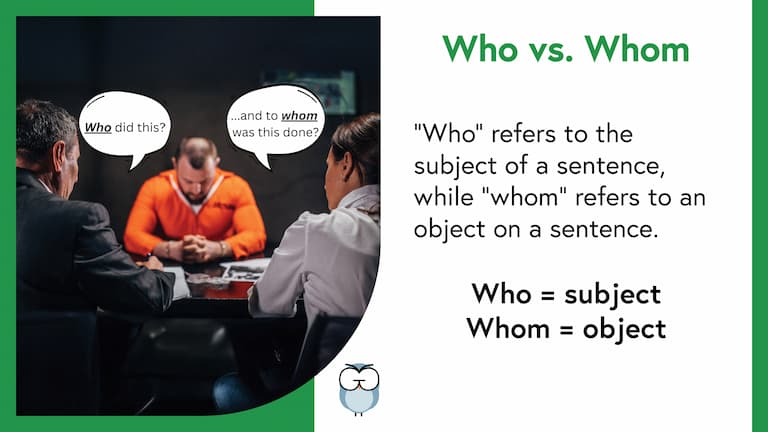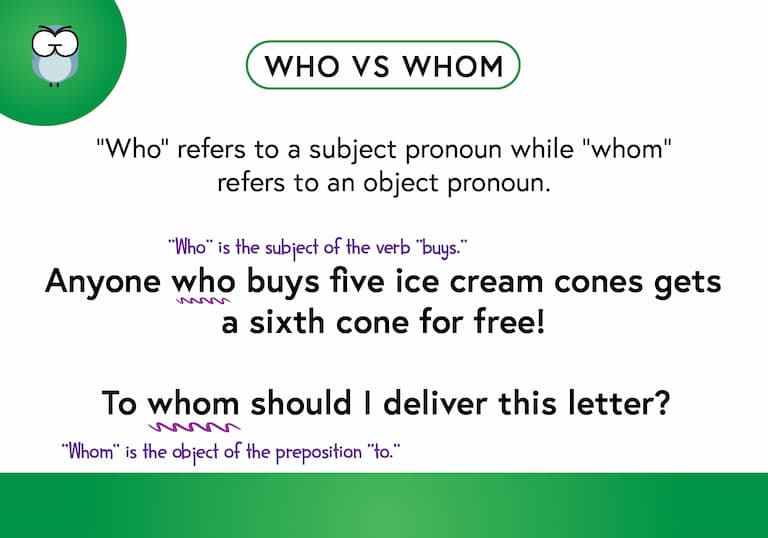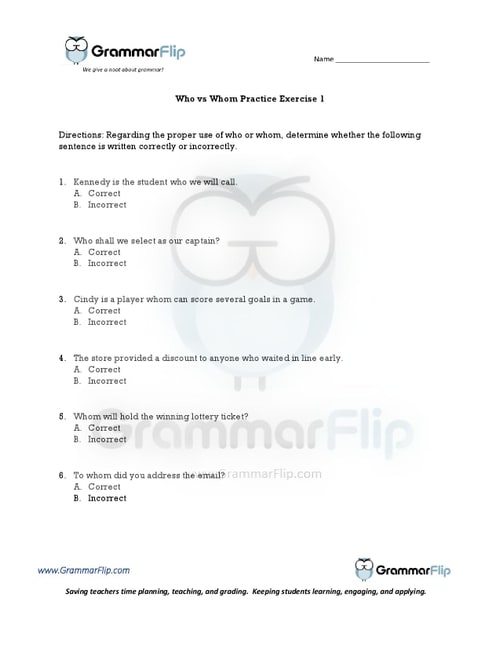When Should I Use Who vs. Whom?
Who and whom are commonly confused, but ‘who’ is used to refer to the subject of a sentence, while ‘whom’ is used to refer to an object.
Some examples of when to use who vs. whom would be the following:
Elizabeth is the only student who got a perfect score on the exam.
– “Who” is the subject of the verb “got.”
Who will be filling in for Mr. Bingham today?
– “Who” is the subject of the verb phrase “will be filling.”
Anyone who buys five ice cream cones gets a sixth cone for free!
– “Who” is the subject of the verb “buys.”
To whom should I deliver this letter?
– “Whom” is the object of the preposition “to.”
Is Nestor the boy with whom you walk home from the bus stop?
– “Whom” is the object of the preposition “with.”
Long-Form Videos: Who vs. Whom
Long-form instructional video lessons allow students to engage with grammar concepts in more depth and detail.
This format provides students with a stronger foundation and a more comprehensive understanding of when to use who vs. whom.
Short-Form Videos: Who vs. Whom
Short-form videos are an excellent way to review grammar concepts. Our two-minute instructional videos help students review the concept of who vs. whom to further solidify their understanding.
Memorable Images: Who vs. Whom

The use of images to connect visual cues with concepts makes it simpler for students to grasp and remember key ideas. GrammarFlip’s memorable images create visual associations that make who vs. whom more engaging and easier to retain.
Definition Cards: Who vs. Whom
Definition cards reinforce grammar concepts by providing clear and concise explanations that students can easily reference for quick review and better retention. GrammarFlip’s definintion cards help students review the concept of who vs. whom to further solidify their understanding.

When You Should Use Who vs. Whom in Your Writing
One trick you can use to determine when to use “who” and when to use “whom” is the following:
If you can replace the “who/whom” word in the sentence with “he” or “she,” then use the word “who.” For example:
Who is at the door?
Correct: He is at the door.
Incorrect: Him is at the door.
If you can replace the “who/whom” word in the sentence with “him” or “her,” then use the word “whom.” For example:
Whom did you see at the door?
Rephrase it first: You did see whom at the door.
Correct: You did see her at the door.
Incorrect: You did see she at the door.
Download a Free Worksheet on Who vs. Whom!
Click the image below to download your free worksheet on who vs. whom!

Need a grammar program that provides the instruction and grading for you?
Explore More GrammarFlip Lessons!
Parts of Speech lessons provide the building blocks of grammar. GrammarFlip covers these topics in detail to ensure a solid foundation is built. First time learners and students seeking to review the parts of speech can both benefit from the instructional videos and slide show reviews.
Parts of the Sentence lessons are critical for understanding how the parts of speech function in language construction. From the basic to the advanced, these lessons will cover a wide range of grammar topics that can be used in any grade level or classroom.
Mechanics and Usage lessons equip students with the necessary skills to communicate clearly to all audiences. With a focus on the application of these concepts in student writing, these lessons tie together both simple constructions of grammar as well as the more complex such that any age or skill level of student will benefit.


